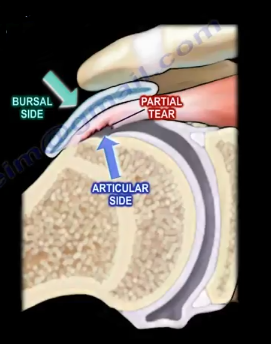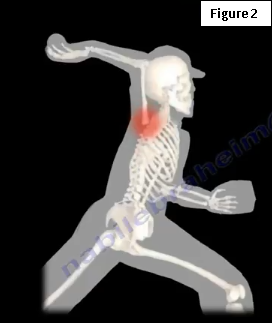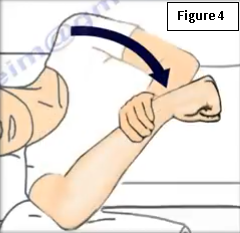Internal impingement of the shoulder is a pathology on the undersurface of the rotator cuff (joint side). An internal impingement is a PASTA lesion plus a SLAP tear. PASTA, an acronym which stands for Partial, Articular surface, Supraspinatus Tendon, Avulsion. As shown in Figure 1, there is a partial tear on the articular side. A SLAP tear is a tear at the top of the glenoid labrum. The SLAP tear is a Superior, Labrum Tear, Anterior to Posterior of the biceps root.

Internal impingement is different than a subacromial impingement, which is pathology underneath the acromion—the bursal side of the cuff. Internal impingement may involve: Scarring and tightness of the posterior capsule, the patient will have diffuse pain on the posterior aspect of the shoulder, and can lead to a glenohumeral internal rotation deficit (GIRD). Internal impingement is mainly seen in overhead throwing athletes. A thrower with shoulder pain should be evaluated for internal impingement. This condition usually occurs during the late cocking and early acceleration phase of throwing. The greater tuberosity of the humerus abuts the posterosuperior glenoid, which entraps the rotator cuff between the glenoid and the humeral head.

The stages involved in throwing:
· Wind up
· Early Cocking
· Late cocking
· Acceleration
· Follow-through
Internal impingement occurs during the Late Cocking and Early Acceleration stages of throwing. The posterior undersurface of the supraspinatus tendon impinges on the posterosuperior glenoid labrum. This occurs during maximum abduction and external rotation of the shoulder with late cocking and early acceleration of throwing. (Figure 2)
Loss of more than 25 degrees of internal rotation at 90 degrees compared to the other side—the loss of internal rotation is due to posterior capsular contracture. The external rotation increases which may lead to the stretching and thinning of the anterior capsule and glenohumeral ligament. The center of rotation of the humeral head shifts posteriorly and superiorly which leads to impingement of the labrum and the rotator cuff as the arm is abducted and externally rotated.
Glenohumeral Internal Rotation Deficit (GIRD)
Gird usually occurs in the throwing shoulder. The loss of internal rotation is measured in degrees and the scapula must be stabilized during measurements.

The Bennett lesion is equal to mineralization or exostosis of the posterior inferior glenoid. This lesion may be found on the AP view or axillary view on an x-ray due to hypertrophy, scarring, and traction of the capsule. (Figure 3)
An MRI arthrogram of the shoulder (PASTA+SLAP) will show rotator cuff partial articular pathology (PASTA lesion) and labral pathology (posterosuperior labrum involvement).

Treatment for the Internal Impingement of the Shoulder can be operative and nonoperative. Nonoperative is preferred and consists of: avoiding aggravating activity, physical therapy for up to six months and posterior capsular stretching with sleeper stretches—a posterior capsular stretch performed with an internal rotation stretch at 90 degrees abduction with scapular stabilization—as well as rotator cuff strengthening therapy. A majority of patients will improve with nonoperative treatment. However, when nonoperative treatment fails, an arthroscopic debridement or repair of the labrum plus debridement of the under surface of the rotator cuff lesion can be done; the cuff can be repaired if the tear is greater than 50%. A posterior capsular release is done in patients with GIRD if conservative treatments fail (Figure 4).
For more information on Shoulder Injuries please check out the link below:
For more information on Orthopaedic Conditions, check out my YouTube Channel:
